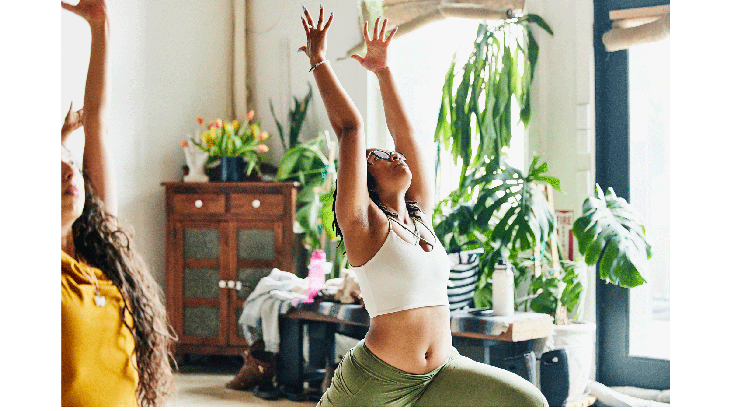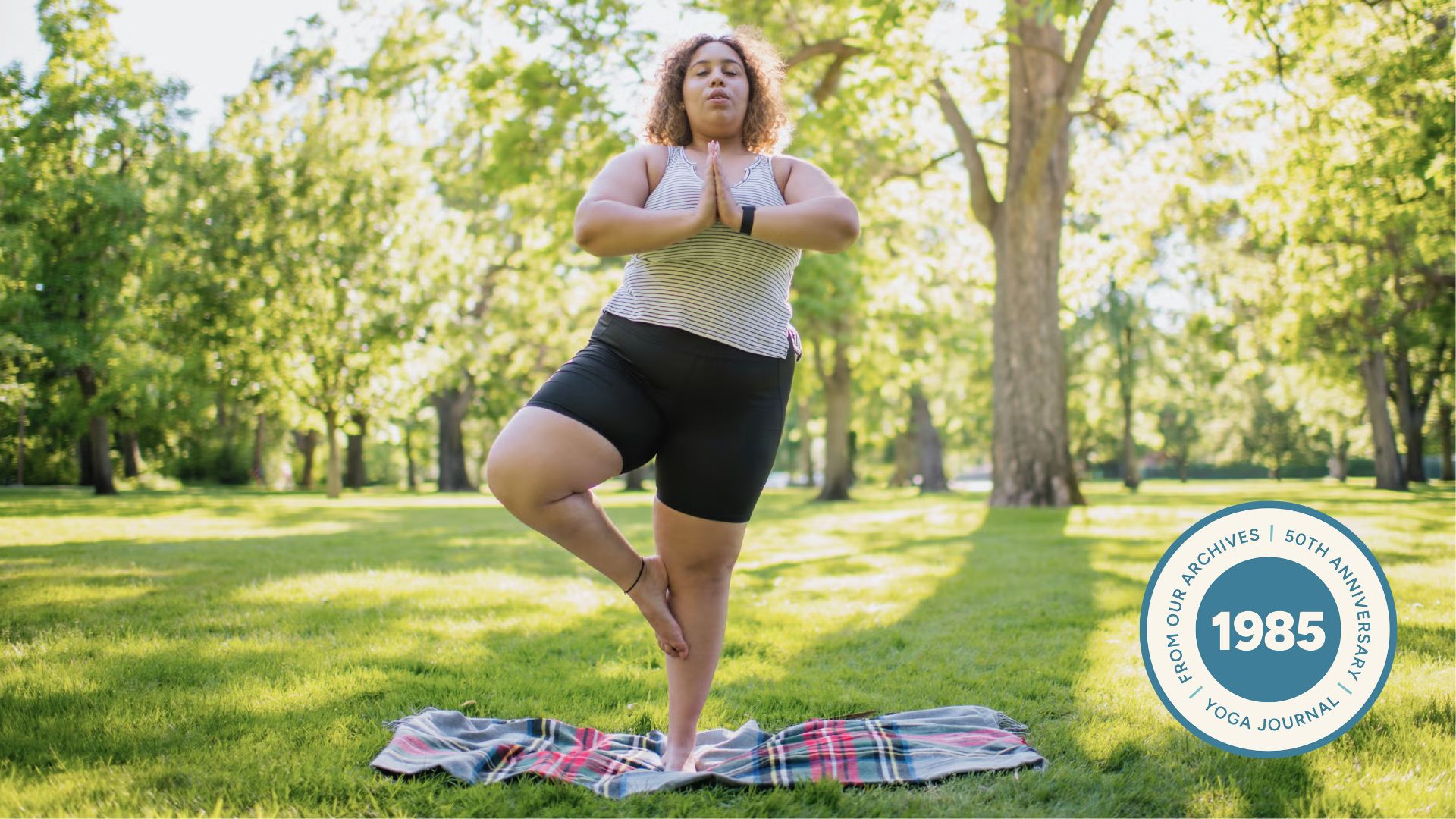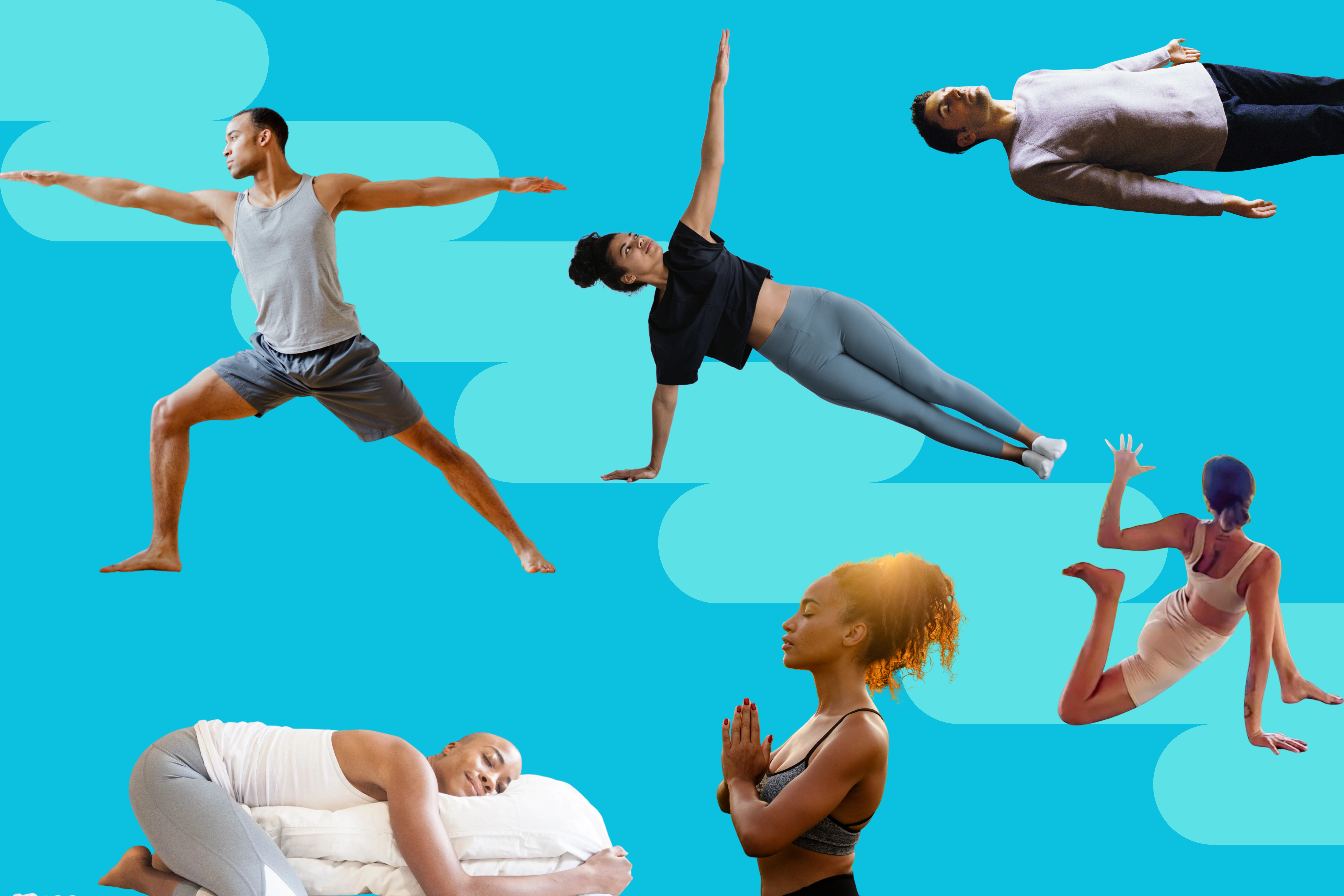“], “filter”: { “nextExceptions”: “img, blockquote, div”, “nextContainsExceptions”: “img, blockquote, a.btn, a.o-button”} }”>
Heading out the door? Read this article on the new Outside+ app available now on iOS devices for members!
>”,”name”:”in-content-cta”,”type”:”link”}}”>Download the app.
Picture it: You’ve been looking forward to unrolling your mat for some much-needed yoga. Class is underway and going seamlessly until you hear the teacher say, “Place your back foot at a 45-degree angle,” or “Bend your front knee to a right angle.”
Instantly, you feel frustrated, discouraged, maybe even a little defeated.
The inclusion of specific angles as a teacher talks you into a yoga pose is intended as a helpful marker, not unlike a visual landmark when you’re giving directions to someone. But if a teacher or student overly focuses on this aspect of a pose, the familiar and well-intentioned cues can derail the entire experience.
Overemphasizing the precise angle of a knee or ankle not only shifts the focus of the posture from the overall experience to a single isolated component, but compelling everyone to conform to a precise angle with no margin of variance doesn’t work for everyone’s physical anatomy. Without any leeway, the cue becomes impossible at best, harmful at worst.
But because yoga teachers can’t possibly know the intricate body mechanics of each student in class, cueing an angle can be helpful in that it quickly helps the entire class understand the general action and shape that’s needed.
Does that mean we should stop cueing degrees and angles? Can we ditch these specifics without sacrificing the intended function of a pose?

Why We Cue Specific Angles in Yoga
A teacher’s tendency to cue specific angles is sometimes correlated with the style and lineage of yoga that they practice. Although all styles of yoga are filled with body parts at right angles and 45 degrees, students of Iyengar yoga may be most familiar with this emphasis on precision. In Light on Yoga, B.K.S. Iyengar explained how to come into Warrior 1 (Virabhadrasana) by writing, “Simultaneously turn the right foot 90 degrees to the right and the left foot slightly to the right. Flex the right knee till the right thigh is parallel to the floor and the right shin perpendicular to the floor, forming a right angle between the right thing and the right calf. The bent knee should not extend beyond the ankle, but should be in line with the heel.”
As intermingled as contemporary classes tend to be, Iyengar’s well-intended influence reaches well beyond his namesake style of yoga. Also, depending on a teacher’s personal experience, they may be more rigid or relaxed in terms of cueing specific degrees.
But fixating on that may contribute to everyone missing the point of the pose. “I tend to interpret those sorts of instructions as mostly a shorthand way of conveying the general shape, rather than about geometrical precision,” says Joe Miller, a New York City-based yoga anatomy and physiology teacher.
That means drawing on the traditional shape as a guide but without taking things literally. The trick, Miller continues, is conveying that to students. In order to help practitioners understand the experience of a posture, the focus needs to be on more than simply the shape. That is, an emphasis on what a pose feels like rather than what it looks like.
“As a teacher, it’s important for us to be familiar with the classical presentation of a posture so that we can understand what experience that posture is intending,” says yoga instructor Pranidhi Varshney, founder of Yoga Shala West in Los Angeles. “It’s also important for us to be able to make that experience accessible to students with limitations, which is most students. We all have some limitation or another.”
One cue does not fit all, says Amy Leydon, a yoga instructor and founder of Soma Yoga Center. “But when teaching group classes, you have to find cues that work for most bodies,” she explains. And almost everyone understands what is meant by a 45-degree angle.
So how can students more realistically interpret these angles, degrees, and poses? And how can teachers support that?
Dos and Don’ts for Students
Teachers in the classes you take hopefully encourage awareness when coaxing you into a pose. If you hear a cue that includes a specific angle and it simply isn’t happening in your body, the following dos and don’ts can help keep the emphasis where it should be—the larger experience of a posture. (Non-attachment, anyone?)
DON’T Force Your Body Into an Impossible Position
“Anatomy plays a role not only in what your physical body can do, but also what it should or should not do,” says Suzanne Levine, MD, a podiatrist and podiatric foot surgeon based in New York City. In some postures, angling the back foot 45 degrees is not just difficult but literally impossible for certain students, she says.
Each skeleton is unique, explains yoga instructor Gwen Lawrence, creator of Power Yoga for Sports. These variations lead to vast differences in mobility and flexibility, making it impossible for everybody to find the same precise angle. When you also factor in varying amounts of experience with yoga, injuries, even tiredness, it becomes even more apparent that not angle will work for everyone. “Your first and foremost concern is not to fit in a box,” she says.
If your body doesn’t move a certain way, it’s telling you something. Listen. When a teacher cues an angle in a pose, take it as a suggestion and not a standard. Then adjust it to what works for your body.
DO Focus on How A Pose Feels, Not How It Looks
“It is much more important to find a position that feels comfortable and sustainable rather than try to fit your body into a predetermined shape,” says Andrew McGonigle, yoga anatomy teacher and author of Supporting Yoga Students with Common Injuries and Conditions.
In other words, prioritize how a pose feels over how it looks. You’re still doing Warrior 2 when your front knee isn’t bent all the way to 90 degrees. So focus on what works for your body in the present moment—not on what the teacher at the front of the room or the person on the mat alongside you is doing. Maybe not even what may have worked for you last week.
“There is no such thing as universally good or bad alignment. Each asana (pose) that is practiced is as unique as the practitioner,” says McGonigle.
DO Play Around in a Pose
Always feel free to explore a range of shapes in any pose to explore the right angle for you, says Lara Land, a trauma-informed yoga trainer and author of The Essential Guide to Trauma Sensitive Yoga: How to Create Safer Spaces for All.
That may mean going beyond a small degree of difference from what is cued, including poses in which you may hear cautionary cues around bending your knee too far forward, such as not taking your front knee past a 90-degree bend in Low Lunge, says Land.
Dos and Don’ts for Teachers
The following insights can help you keep sight of how to help all students experience the larger practice of yoga, which goes well beyond the specific shape.
DO Know the Purpose of the Pose
“Too many times, as yoga teachers, we repeat instructions we’ve heard from teachers before us,” says Land. These suggestions can be taken out of context and inaccurately shared as blanket statements.
They might also bee repeated without an understanding of the intention behind the shape, says Miller. That’s where things get problematic. “Rather than trying to match some arbitrary angle, find a version that embodies the aspects of the pose you’re prioritizing,” he says.
Take Warrior 1. “The idea is to ground the back heel so you’re more stable than you would be in, say, a High Lunge,” says Miller. He explains that all the pose requires is for the back toes to angle in enough to allow the hips to face somewhat forward. That, and not the precise angle, is the entire point of the position of the back foot. Once you know that, you have a better understanding of how to cue the pose.
If finding stability in Warrior 1 means you angle your toes more toward the front of the mat as opposed to the front corner, do that, says Miller. If shortening the stance so students can still ground the back heel helps you feel more stable, do that. You can also offer High Lunge as an alternative.
“It all depends on what the priority is,” says Miller.
DO Offer Students Options
“As a teacher, you have to be clear that you’re asking for something more or less like that, rather than telling them to get out their protractors and make it exactly 45 degrees,” says Miller.
Encourage students to ease into a pose and include qualifying phrasing, such as positioning the foot at “approximately 45 degrees,” positioning the knee “toward 90 degrees,” finding “more or less” a right angle, and moving “somewhere in the vicinity of” a particular degree angle. That clarifies for students that the angle is a guidepost and not an edict.
DO Know What Compensating Looks Like
Continuing with the example of Warrior 1, the cue to turn the back foot to 45 degrees can cause the body to strain and other muscles to adapt—and not in helpful ways.
“If someone had really tight hip flexors, that person would then start to introduce compensatory actions to alleviate tension while trying to maintain ‘good alignment,’” explains yoga instructor Hiro Landazuri, founder of Body Smart Yoga.
In Warrior 1, that compensation can look like bending the back knee, leaning inward and shifting weight toward the arches of the feet, and coming into a backbend, explains Landazuri. “These three things will alleviate the tension felt in the hip flexor, but will simultaneously drive tension into other areas,” he says.
The potential fallout from this includes compression in the lower back, taxed ligaments and tendons (especially in the knee), and potential joint destabilization, explains Landazuri.
As you pay attention to the entire bodies of your students, you’ll start to see when they’re overcompensating. A simple encouraging word to adjust their back foot can bring them back to safer alignment.
DON’T Think of “Alignment” as an Ideal
The ultimate goal is tuning into sensation, not alignment, says Landazuri. Shift your focus to whether a shape can help the student experience stretching or strengthening in the targeted area. “Use alignment as a starting point—a framework to the posture, not an ideal to reach,” explains Landazuri.
McGonigle notes that even the term “alignment” is troublesome as it is used to describe how the body “should” be positioned in each pose. “We must be open to deviating from it in order to make yoga inclusive to each unique body,” he says.
DO Keep Your Attention on the Individual
Look at the bodies in your classes and you’ll notice that no two Warrior 2s are ever exactly the same. There’s no need to coerce a specific angle from all your students.
“The student, when set up with the right circumstances, is in the best position to determine the expression of the pose which is correct for them,” says Land. ”My focus is returning the power back to the student.”







